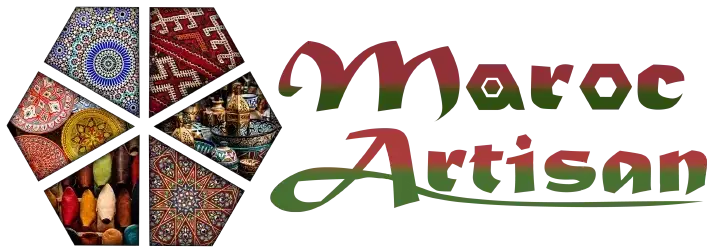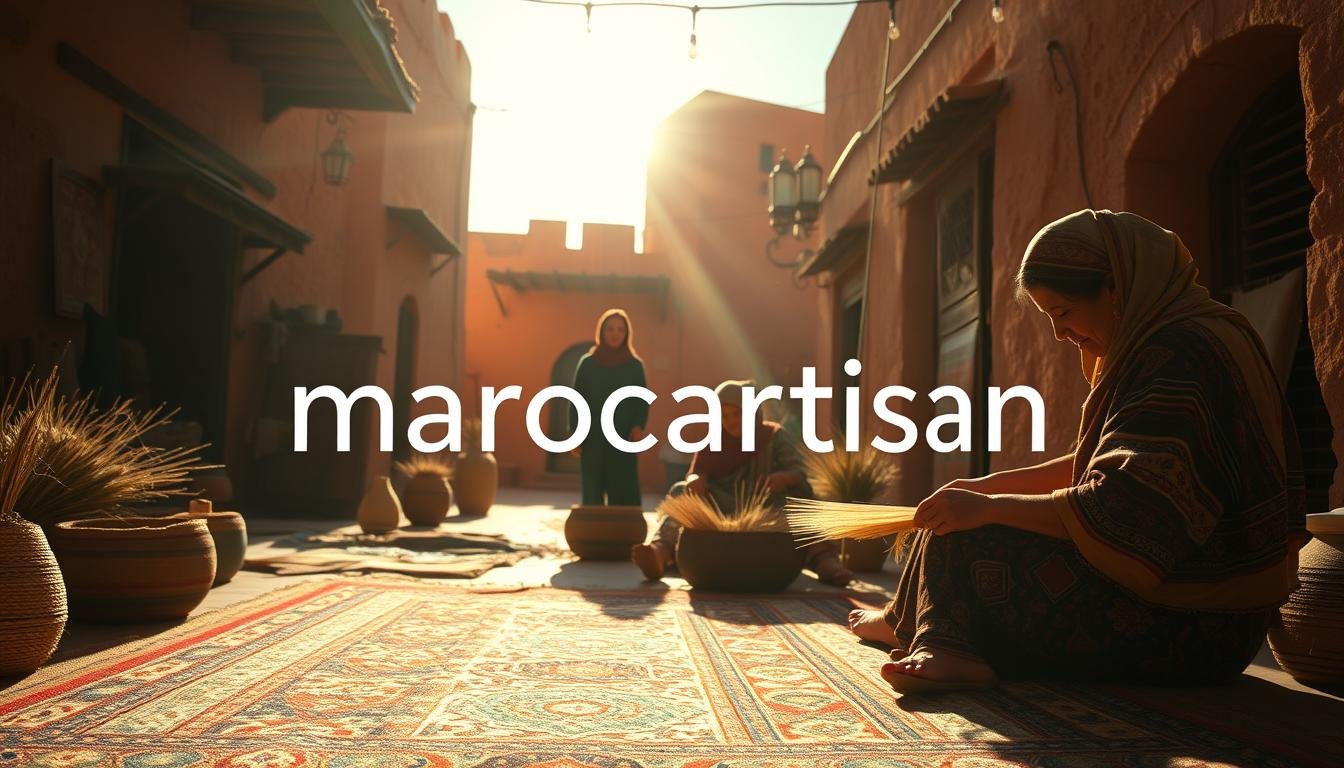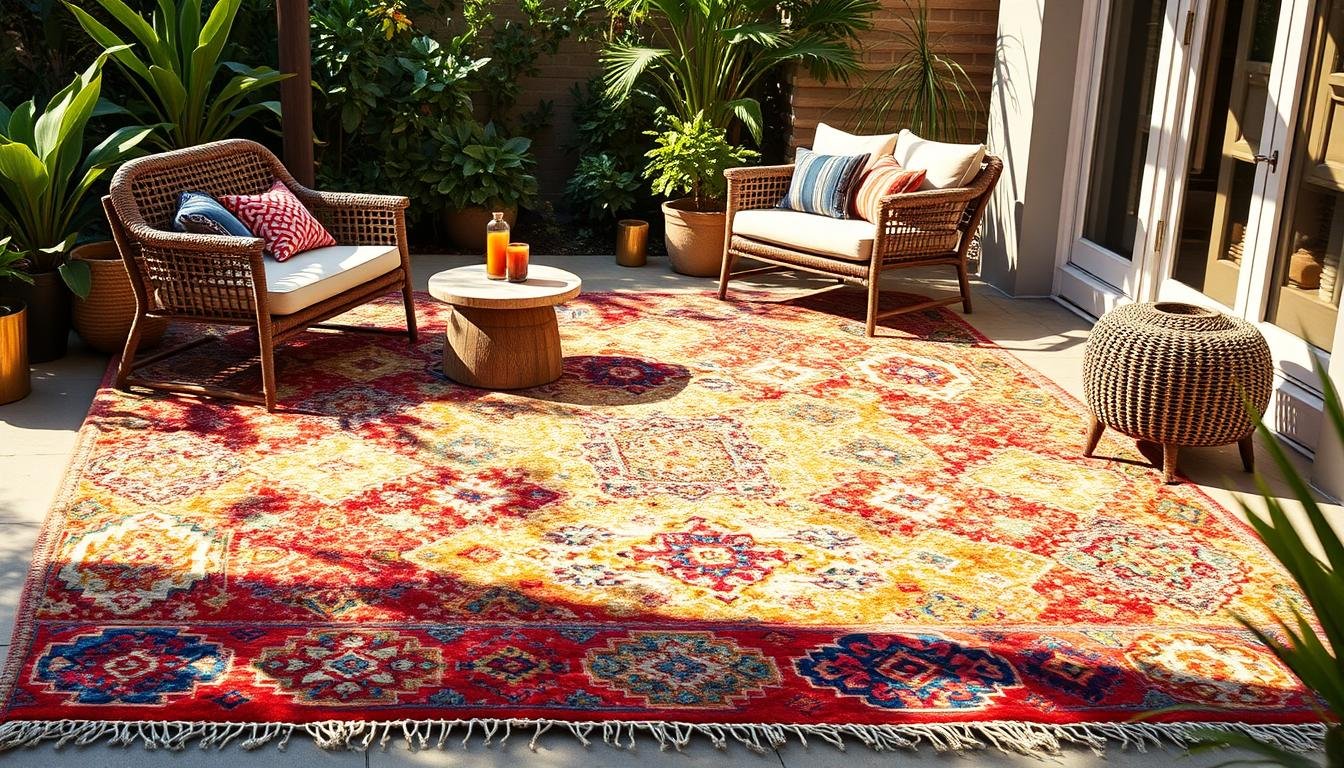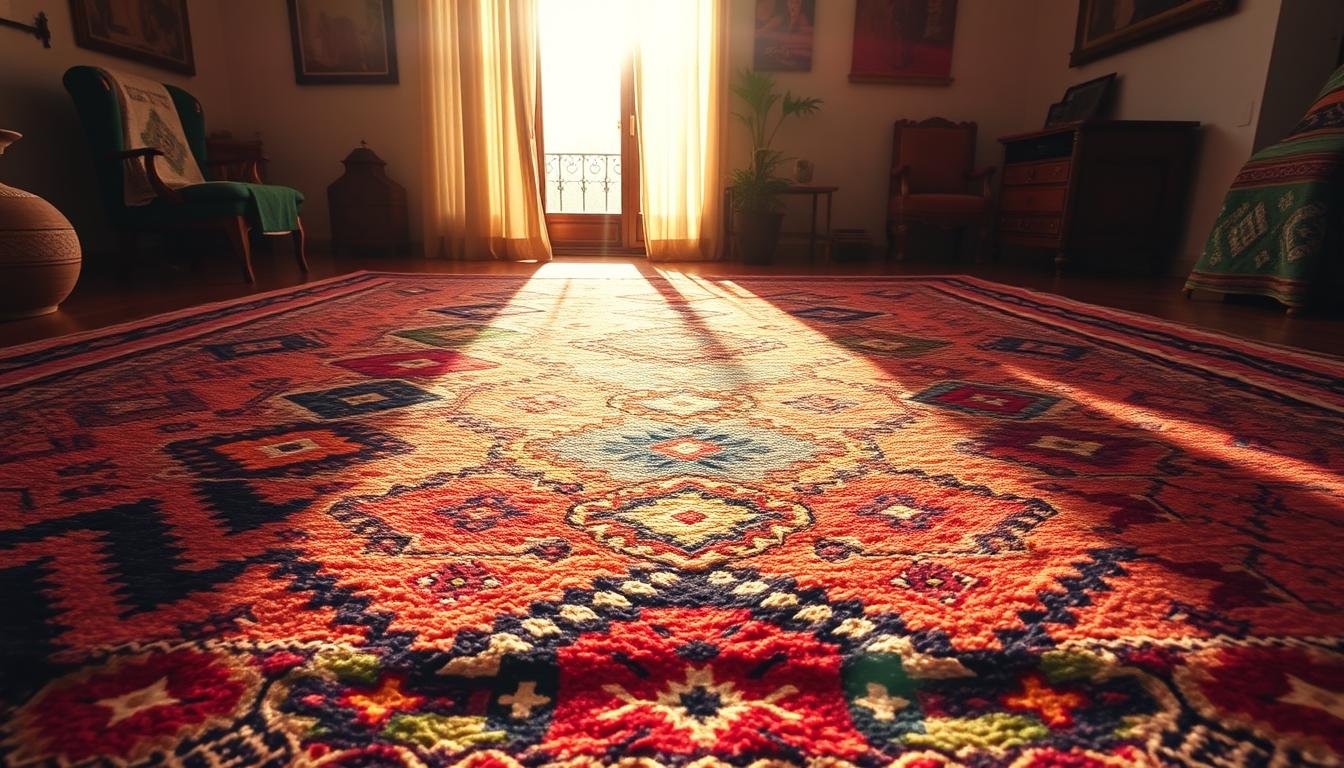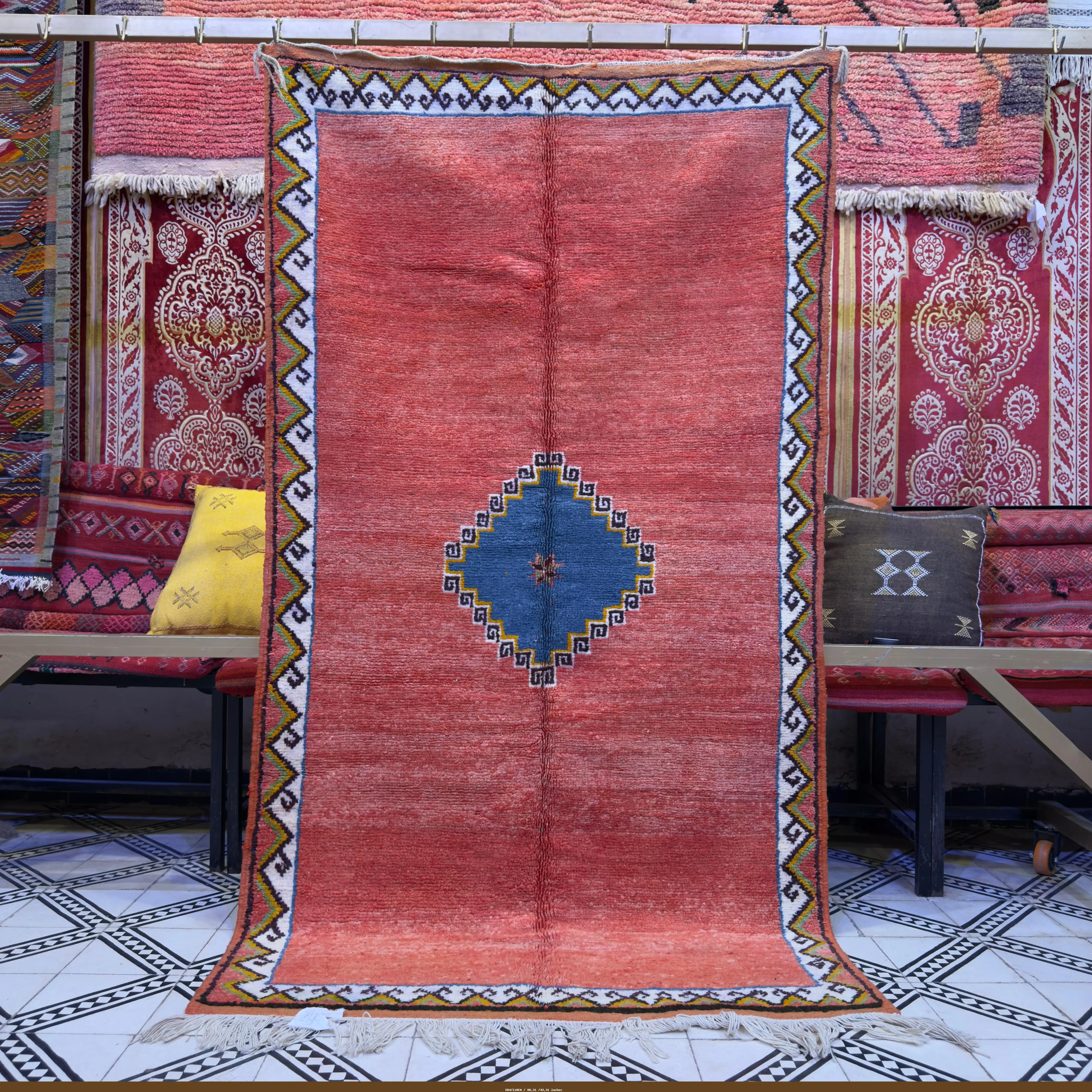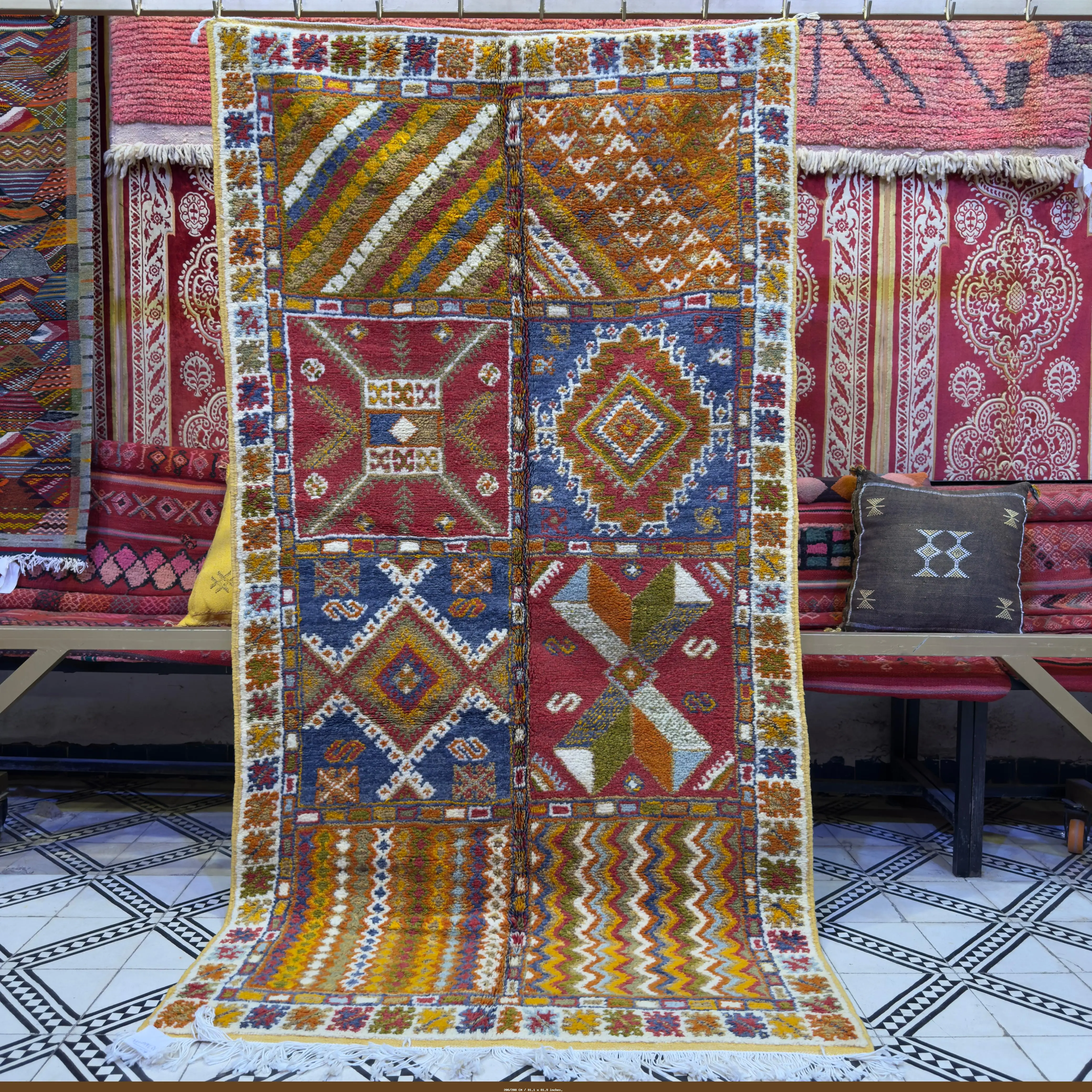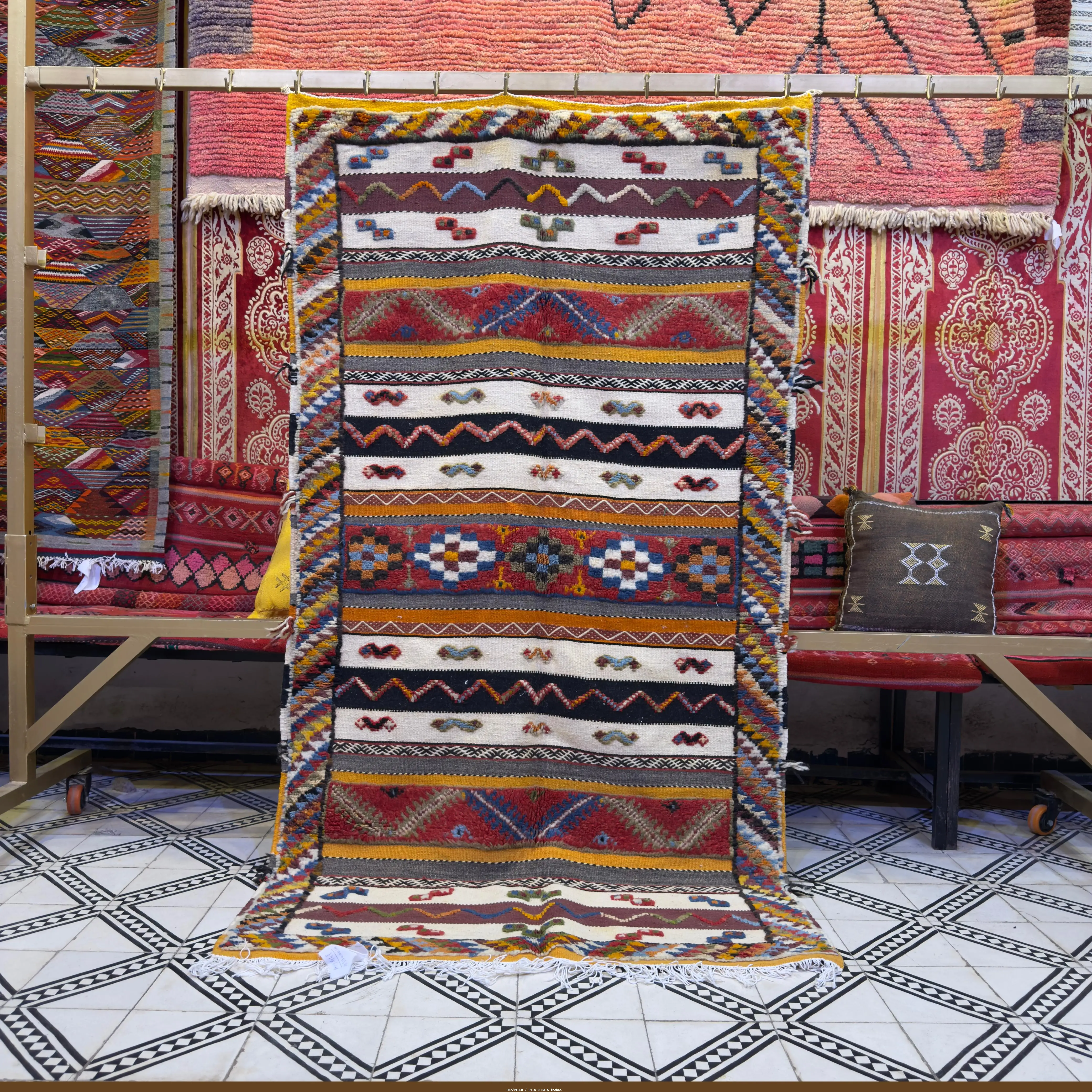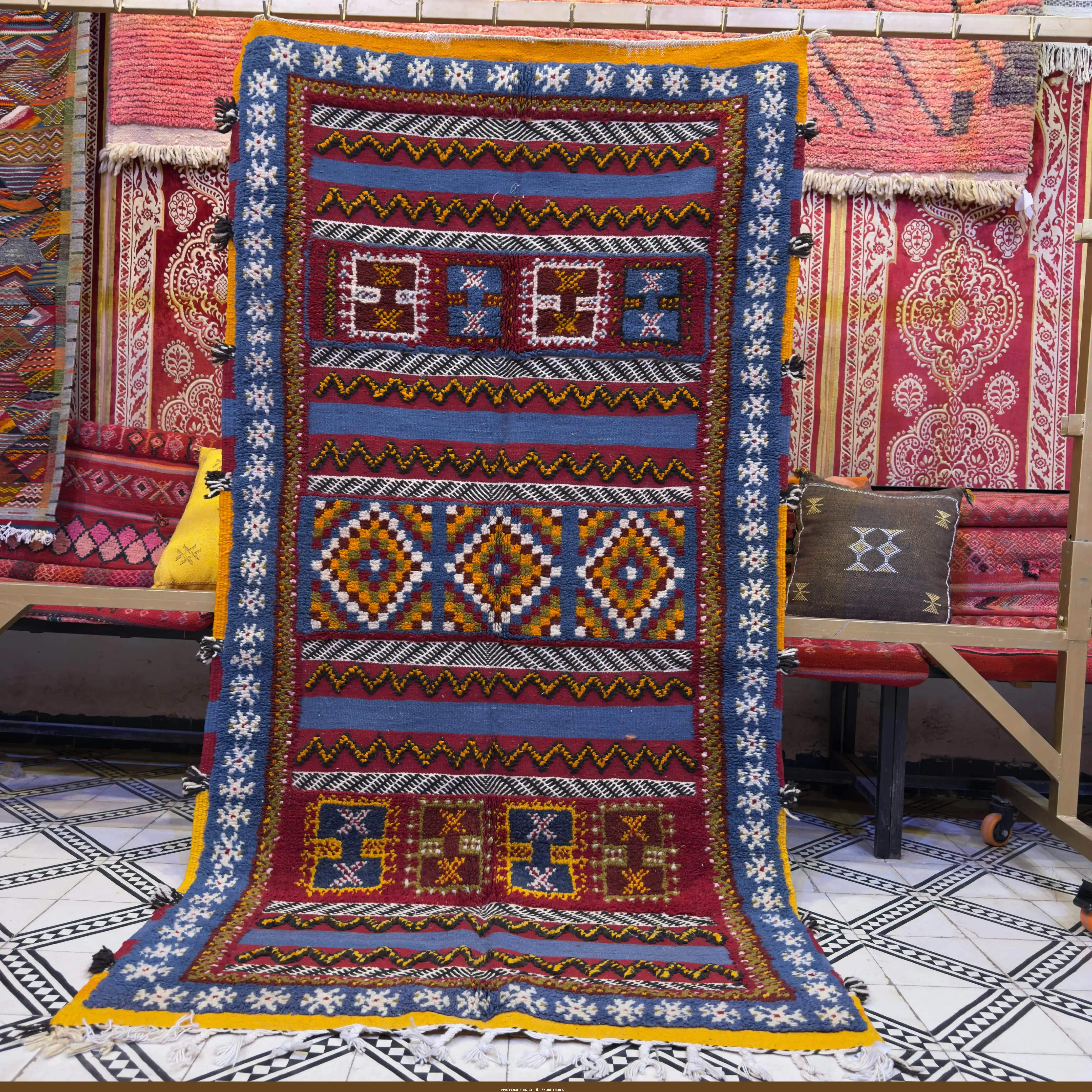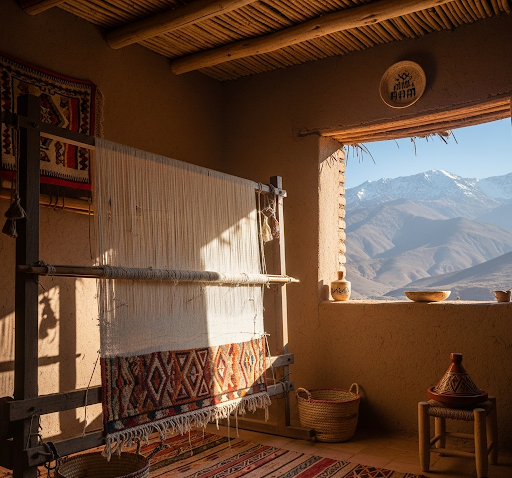
04 Aug 2025
Indoor Outdoor Rugs
In the quiet, rugged expanse of Morocco's Atlas Mountains, far from the bustling souks of Marrakech, a timeless art form is practiced daily. Here, Berber (Amazigh) women create some of the world's most sought-after textiles, not in factories, but in their own homes, using techniques passed down through countless generations. To understand the soul of a Berber rug is to understand the life of the woman who created it, a life where nature, community, and artistry are inextricably woven together.
This is a glimpse into a day in the life of a Berber weaver, a journey behind the loom to see how a simple ball of wool is transformed into a masterpiece of storytelling.

Morning: A Dialogue with Nature
The weaver's day begins with the sun. It doesn't start at the loom, but outdoors, in the vast landscape that serves as both her pantry and her palette. The first task is often tending to the family's flock of sheep, the very source of the precious wool that forms the foundation of her craft.
The wool, once shorn, is carried to a nearby stream to be washed, the cold mountain water cleansing it of its impurities. This is also the time for gathering dye materials. The weaver's knowledge of local botany is profound. She collects mint and almond leaves to create the vibrant, calming color for a green area rug, saffron for yellow, and madder root for deep reds. Every color in her rug is a piece of the landscape, a pigment borrowed from the earth.
Midday: The Language of the Loom
Back at home, the loom, often a simple wooden frame passed down from her mother, awaits. This is where the physical creation begins, but the mental creation started long ago. A Berber weaver rarely works from a pre-drawn pattern. The design exists in her mind and in her heart, a unique combination of ancient symbols and personal expression.
She begins by setting the warp threads, the strong vertical foundation of the rug. Then, knot by knot, the story unfolds. A diamond for protection, a zig-zag for a flowing river, a checkerboard pattern for a bountiful harvest. These are not just decorative elements; they are a language. She might be weaving a prayer for her family's health, documenting a marriage, or celebrating the birth of a child. For ambitious projects, like the large area rugs that will cover an entire floor, this process will take months of patient, dedicated work.
Afternoon: The Rhythm of Creation
The afternoon is filled with the rhythmic sounds of the loom: the soft thud of the comb packing the weft threads down, the quiet whisper of wool being knotted. If she is working on a green area rug, she might be thinking of the lush valleys of spring, weaving that feeling of peace and new life directly into the pile.
This is often a communal time. Other women from the village might gather, each at her own loom, their hands moving in a synchronized, practiced dance. They share stories, sing songs, and drink mint tea. The loom becomes the center of their social world, a place where community is strengthened and traditions are kept alive. The skills are passed organically from mother to daughter, not through formal lessons, but through observation and shared experience.
Evening: A Legacy Woven
As the sun sets, the day's work on the loom comes to a close. The progress may seem small—perhaps only a few inches have been added to one of the large area rugs—but each row is a line in a story, a permanent record of that day.
The rug is more than an object to be sold. It is a diary, a talisman, and a deep connection to her ancestors and her descendants. It is a piece of her soul, given physical form.
Conclusion: Artistry in Every Fiber
When you bring a Berber rug into your home, you are not just acquiring a beautiful object. You are becoming a custodian of this tradition. You are holding a piece that contains the mountain sun, the river water, the color of wild mint, and the stories and dreams of the woman who spent her days at the loom. It is a profound connection to a way of life, an artistry woven into every single fiber.
Dans l'étendue calme et accidentée des montagnes de l'Atlas au Maroc, loin des souks animés de Marrakech, une forme d'art intemporelle est pratiquée quotidiennement. Ici, les femmes berbères (Amazighes) créent certains des textiles les plus recherchés au monde, non pas dans des usines, mais dans leurs propres maisons, en utilisant des techniques transmises de génération en génération. Comprendre l'âme d'un tapis berbère, c'est comprendre la vie de la femme qui l'a créé, une vie où la nature, la communauté et l'art sont inextricablement liés.
Ceci est un aperçu d'une journée dans la vie d'une tisserande berbère, un voyage derrière le métier à tisser pour voir comment une simple pelote de laine est transformée en un chef-d'œuvre de narration.

Matin : Un dialogue avec la nature
La journée de la tisserande commence avec le soleil. Elle ne commence pas au métier à tisser, mais à l'extérieur, dans le vaste paysage qui lui sert à la fois de garde-manger et de palette. La première tâche consiste souvent à s'occuper du troupeau de moutons de la famille, la source même de la précieuse laine qui constitue le fondement de son art.
La laine, une fois tondue, est transportée jusqu'à un ruisseau voisin pour y être lavée, l'eau froide de la montagne la purifiant de ses impuretés. C'est aussi le moment de cueillir les matières tinctoriales. La connaissance de la botanique locale par la tisserande est profonde. Elle cueille des feuilles de menthe et d'amandier pour créer la couleur vibrante et apaisante d'un tapis vert, du safran pour le jaune et de la racine de garance pour les rouges profonds. Chaque couleur de son tapis est un morceau du paysage, un pigment emprunté à la terre.
Midi : Le langage du métier à tisser
De retour à la maison, le métier à tisser, souvent un simple cadre en bois transmis par sa mère, l'attend. C'est ici que commence la création physique, mais la création mentale a commencé il y a longtemps. Une tisserande berbère travaille rarement à partir d'un modèle prédessiné. Le dessin existe dans son esprit et dans son cœur, une combinaison unique de symboles anciens et d'expression personnelle.
Elle commence par monter les fils de chaîne, la solide fondation verticale du tapis. Puis, nœud par nœud, l'histoire se déroule. Un losange pour la protection, un zigzag pour une rivière qui coule, un motif en damier pour une récolte abondante. Ce ne sont pas de simples éléments décoratifs ; c'est un langage. Elle peut être en train de tisser une prière pour la santé de sa famille, de documenter un mariage ou de célébrer la naissance d'un enfant. Pour les projets ambitieux, comme les grands tapis qui couvriront un sol entier, ce processus prendra des mois de travail patient et dévoué.
Après-midi : Le rythme de la création
L'après-midi est rempli des sons rythmés du métier à tisser : le bruit sourd du peigne qui tasse les fils de trame, le doux murmure de la laine qui est nouée. Si elle travaille sur un tapis vert, elle pense peut-être aux vallées luxuriantes du printemps, tissant ce sentiment de paix et de nouvelle vie directement dans le velours.
C'est souvent un moment communautaire. D'autres femmes du village peuvent se rassembler, chacune à son propre métier à tisser, leurs mains se déplaçant dans une danse synchronisée et exercée. Elles partagent des histoires, chantent des chansons et boivent du thé à la menthe. Le métier à tisser devient le centre de leur monde social, un lieu où la communauté est renforcée et les traditions sont maintenues en vie. Les compétences se transmettent organiquement de mère en fille, non pas par des leçons formelles, mais par l'observation et l'expérience partagée.
Soir : Un héritage tissé
Au coucher du soleil, le travail de la journée sur le métier à tisser prend fin. Les progrès peuvent sembler minimes — peut-être que seuls quelques centimètres ont été ajoutés à l'un des grands tapis — mais chaque rangée est une ligne dans une histoire, un enregistrement permanent de cette journée.
Le tapis est plus qu'un objet à vendre. C'est un journal intime, un talisman et un lien profond avec ses ancêtres et ses descendants. C'est un morceau de son âme, qui a pris une forme physique.
Conclusion : L'art dans chaque fibre
Lorsque vous introduisez un tapis berbère dans votre maison, vous n'acquérez pas seulement un bel objet. Vous devenez le gardien de cette tradition. Vous tenez entre vos mains une pièce qui contient le soleil de la montagne, l'eau de la rivière, la couleur de la menthe sauvage, ainsi que les histoires et les rêves de la femme qui a passé ses journées au métier à tisser. C'est un lien profond avec un mode de vie, un art tissé dans chaque fibre.
En la tranquila y escarpada extensión de las montañas del Atlas en Marruecos, lejos de los bulliciosos zocos de Marrakech, se practica a diario una forma de arte atemporal. Aquí, las mujeres bereberes (Amazigh) crean algunos de los textiles más codiciados del mundo, no en fábricas, sino en sus propios hogares, utilizando técnicas transmitidas a través de innumerables generaciones. Comprender el alma de una alfombra bereber es comprender la vida de la mujer que la creó, una vida donde la naturaleza, la comunidad y el arte están inextricablemente entrelazados.
Este es un vistazo a un día en la vida de una tejedora bereber, un viaje detrás del telar para ver cómo una simple madeja de lana se transforma en una obra maestra de narración.

Mañana: Un diálogo con la naturaleza
El día de la tejedora comienza con el sol. No comienza en el telar, sino al aire libre, en el vasto paisaje que le sirve tanto de despensa como de paleta. La primera tarea suele ser cuidar del rebaño de ovejas de la familia, la fuente misma de la preciosa lana que constituye la base de su arte.
La lana, una vez esquilada, es transportada a un arroyo cercano para ser lavada, el agua fría de la montaña la purifica de sus impurezas. Este es también el momento de recolectar materiales para teñir. El conocimiento de la botánica local de la tejedora es profundo. Recoge hojas de menta y almendro para crear el color vibrante y relajante de una alfombra verde, azafrán para el amarillo y raíz de rubia para los rojos intensos. Cada color de su alfombra es un pedazo del paisaje, un pigmento prestado de la tierra.
Mediodía: El lenguaje del telar
De vuelta en casa, el telar, a menudo un simple marco de madera heredado de su madre, la espera. Aquí es donde comienza la creación física, pero la creación mental comenzó hace mucho tiempo. Una tejedora bereber rara vez trabaja a partir de un patrón prediseñado. El diseño existe en su mente y en su corazón, una combinación única de símbolos antiguos y expresión personal.
Comienza montando los hilos de la urdimbre, la sólida base vertical de la alfombra. Luego, nudo a nudo, la historia se desarrolla. Un rombo para la protección, un zigzag para un río que fluye, un patrón de tablero de ajedrez para una cosecha abundante. No son simples elementos decorativos; es un lenguaje. Puede estar tejiendo una oración por la salud de su familia, documentando una boda o celebrando el nacimiento de un hijo. Para proyectos ambiciosos, como las grandes alfombras que cubrirán un suelo entero, este proceso llevará meses de trabajo paciente y dedicado.
Tarde: El ritmo de la creación
La tarde está llena de los sonidos rítmicos del telar: el golpe sordo del peine que aprieta los hilos de la trama, el suave susurro de la lana que se anuda. Si está trabajando en una alfombra verde, puede que esté pensando en los exuberantes valles de la primavera, tejiendo ese sentimiento de paz y nueva vida directamente en el pelo de la alfombra.
Este es a menudo un momento comunitario. Otras mujeres del pueblo pueden reunirse, cada una en su propio telar, sus manos moviéndose en una danza sincronizada y experta. Comparten historias, cantan canciones y beben té de menta. El telar se convierte en el centro de su mundo social, un lugar donde se fortalece la comunidad y se mantienen vivas las tradiciones. Las habilidades se transmiten orgánicamente de madre a hija, no a través de lecciones formales, sino a través de la observación y la experiencia compartida.
Noche: Un legado tejido
Al ponerse el sol, el trabajo del día en el telar llega a su fin. El progreso puede parecer mínimo —quizás solo se han añadido unos pocos centímetros a una de las grandes alfombras— pero cada fila es una línea en una historia, un registro permanente de ese día.
La alfombra es más que un objeto para vender. Es un diario, un talismán y un vínculo profundo con sus antepasados y sus descendientes. Es un pedazo de su alma, que ha tomado forma física.
Conclusión: El arte en cada fibra
Cuando introduces una alfombra bereber en tu hogar, no solo adquieres un objeto hermoso. Te conviertes en el custodio de esta tradición. Tienes en tus manos una pieza que contiene el sol de la montaña, el agua del río, el color de la menta silvestre, así como las historias y los sueños de la mujer que pasó sus días en el telar. Es un vínculo profundo con un modo de vida, un arte tejido en cada fibra.
